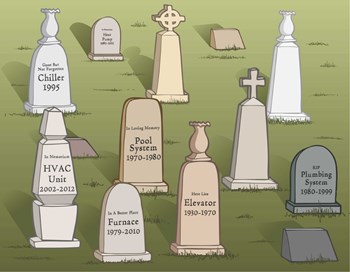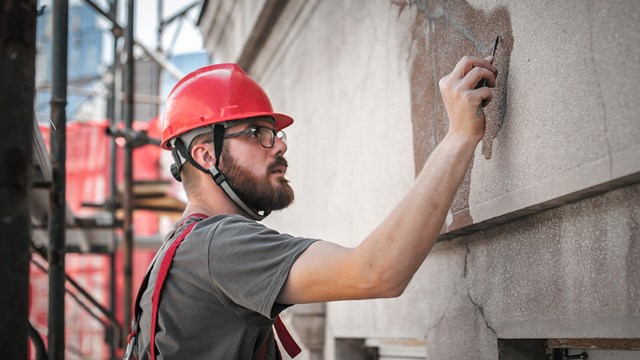
Nothing lasts forever, and though you can’t predict the moment a piece of building equipment will break down, you can prepare for it. Even the toughest boiler, HVAC unit, or elevator will eventually tucker out and need major repairs, or just give up the ghost and have to be replaced. And with Chicago’s penchant for hot summers and cold winters, parts of a building sometimes must be replaced more frequently than might usually be expected elsewhere in the nation.
That’s why working estimates of usable life spans of various building systems can be very helpful to management when planning short- and long-term budgets and capital improvement projects. For some communities, these estimates are a part of a regular evaluation of the facilities. Whether or not this evaluation is a part of your community’s management process, knowing about the life spans and maintenance needs of your building’s systems should be a part of your understanding of your community. Having such knowledge can help you prepare for the worst and in doing so, also help you save some money.
Finite Lives
The longevity of any building system depends upon many factors including the type of system, be it the roof or the windows or the elevators or the plumbing, how often it is used, how old it is, how well it’s been cared for, and even the effects of inclement weather. It’s axiomatic that the best-run buildings will have every pump on every system labeled, and a record kept of each servicing and replacement of every part on each piece of equipment or building system.
Generally speaking, hot water heaters in multi-family buildings will last for just a decade or so. The life spans of HVAC components vary depending upon the type of system, but usually they will last for 15 to 30 years. “There are old Cleveland boilers in Chicago which are approaching 100 years of service. Many have been partially or nearly completely rebuilt, piece-by-piece. Efficient pre-packaged boilers are the more common choice and require minimal maintenance and have a useful life of 20 to 30 years,” says Phillip Mahan, president of Structural Technologies in Chicago.
Elevators typically last for 30 to 40 years, with proper maintenance, says Mark A. Waldman, SE, PE, LEED AP, principal structural engineer at Waldman Engineering Consultants in Chicago. “If it’s a hydraulic lift elevator, six stories or less, or in the primary range in Chicago, buildings that are 50 or 60 years old. We had a program in Chicago where they were required to replace those main seals and bearings, and they’ve since kind of phased it out. Usually people will refurbish the interior of the car in 35 or 30 years, and some folks let it go longer than that,” he says. That 30-year mark is also when controls need to be replaced as well.
Elevator service contractors usually check the system monthly, noting the system’s condition and recent maintenance in a log in the machine room. The contractor will do a visual inspection of the system, and then oil and grease the system if it is needed. If necessary, an elevator contractor (which maintains and sells these systems), can be hired to evaluate the system and put together specifications for improvements to the system ordered by the board, then help in the hiring process.
The overall electrical system of the building usually doesn’t need to be replaced. Often, old wiring is still fine (up to 50 years old or so) and only breaker boxes and other parts of the system need to be replaced, and those only on a case-by-case basis. Some building boards of directors include a line item for electrical system repairs in their capital reserve budget.
When repairs to a trash compactor exceed half the cost to replace the unit, replacement is probably the best option, industry experts say. Unfortunately that rule isn’t applicable to other building systems. HVAC systems, for example, have many different components including cooling towers, water chillers, air handlers and heat exchangers.
Roofing is one the most carefully inspected part of a building in reserve studies. Obviously, it’s a very important part of a structure, but a poorly maintained roof can lead to all sorts of horrible, costly issues.
“No matter what material we’re looking at, it’s one of those 20 year time frames. They have 30 year shingles, 25 year shingles, but we’re always kind of looking to 20 to 25 years,” in reserve studies, says Daniel Isles, senior associate at On-Site Insight, a Massachusetts-based company, which does capital assessments throughout the Chicagoland area. “It’s one of those things that can vary drastically depending on the weather conditions. If they have lots of standing water on the roof, that’s a huge problem. Moisture is going to have a huge impact, as well as sun exposure. If it’s really shaded, north facing, you’re going to get a lot of organic growth on there. On the other hand, a roof that gets a ton of sun, there’s going to be UV damage,” he says. Experts recommend that roofs of co-ops and condos be checked at least annually for any defects, holes, leaks or any other problems. All problems should be immediately fixed, before they become major problems.
And while they may not seem like a building system per se, building exteriors are crucial to maintaining the health of the building’s structure. Concrete foundations and exterior structures like balconies need to be monitored over the years. “The snowball effect of getting a little crack, can contribute to more water infiltration. We usually look at a brand new brick elevation, if it’s well done, it can last a very long time. You’re not even really going to have to touch it for 10 or 15 years when you have to do caulking work. Down the road a ways, anything older than that, you’ll have some brick cracking and replacing,” says Isles.
Typically, when a company is called in to help a residential building, management already knows there could be a maintenance problem. An engineer assesses the building and its condition, through a visual inspection and acoustic inspection, and sometimes even using ground penetrating radar.
Proper maintenance is the most important of all factors that can extend the life span of any building system. Other factors such as foot traffic may not be able to be controlled, nor of course, can the weather. So make sure your building staff takes care of what it can.
Scheduling Upgrades
A building’s administrators should collaborate with their service pros to determine whether it’s better to repair a failing system or replace it. Saving money for residents is part of the job of a board, and that’s where capital reserve studies come in. As part of capital reserve studies, major systems in the building are evaluated to determine how much usable life they have left. This is done through a visual inspection of the building—by professionals referring to manufacturer’s specifications on the system—and through evaluating information on problems and repairs done to the systems.
Also for a reserve study, maintenance professionals who service the building will be consulted to evaluate the longevity of the system and to help give recommendations. Especially for the more intricate systems and machinery, “Replacement often involves the replacement of entire systems ... not just specific components as the system approaches the end of its useful life. A mechanical engineer should be consulted at that time to evaluate the requirements of the structure and to either design the replacement system or coordinate the design with a licensed mechanical contractor to achieve a cost effective, energy-efficient and durable solution,” says Mahan.
The frequency with which a building conducts capital reserve studies varies from community to community and is partly dependent upon the size and type of community. These studies are usually done by an engineering firm or another firm which specializes in such work. Experts recommend doing a capital reserve study of a co-op community every 5 to 10 years and doing a reserve study every 5 years for a condo community. “We review maintenance logs, we have a pre-inspection survey. We meet with maintenance people or the property manager, and that pre-inspection meeting really is helpful in determining what problem areas they’re having. You can’t fully investigate or resolve those issues in a reserve study, but you have to dig down deep enough that backs up your opinions on cost,” says Waldman.
Building boards should try to regularly set funds aside for future work on the building’s plumbing system, which has a 50-plus year life span. Many buildings have a plumbing repair fund, which residents contribute to as a funding source for when repairs are needed. Electrical systems also can benefit from planning. Managers of some buildings set aside money for replacement of transformers and switch gear systems, machinery which lasts about 25 years.
The management of some buildings will prepare for regular work on elevators, such as refurbishing the interior of the cabs. But elevator system upkeep can be costly, and so property managers and board members should properly vet those whom they are considering hiring to maintain and upgrade the systems.
Often elevator maintenance is separated into two line items in the capital reserve budget: interior cab renovations, which are done every 12 to 15 years; and modernizing the system, which is done every 25 to 30 years. Updating the entire system is very expensive, because all of the controls are upgraded for technology and safety.
Because of advances in technology, elevator control systems have life spans of only 20 to 25 years. The motor and cabs of an elevator system can be antiquated, but all of the controls are computerized these days and thus, must be regularly updated.
Thanks to Moore’s Law and the speed of change in the computer era, some electrical systems, such as security systems and entry systems, may need to be replaced more frequently than other building systems. And some residents want greater security or more convenience, so changes to the system are made to make things easier, such as by upgrading to a keyless entry. And due to technology constantly morphing, a building’s computer network might have a life span of only 15 or 20 years.
Jonathan Barnes is a freelance writer and regular contributor to The Chicagoland Cooperator. Editorial Assistant Tom Lisi contributed to this article.






Leave a Comment